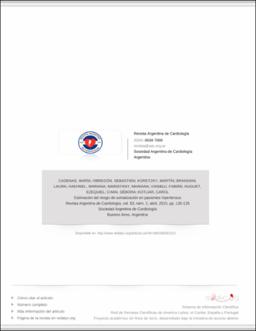| dc.description.abstract | Background: Somatization in hypertensive patients affects not only their quality of life but also their adherence to treatment
and the physician-patient relationship, constituting an expensive health care issue. The possibility of estimating the risk of
somatization in these patients could promote an individualized management of their manifestations.
Objectives: The goal of this study was to stratify the risk of somatization in a cohort of patients with essential hypertension
and to characterize the hemodynamic variables associated with the risk of somatization in hypertensive patients.
Methods: A total of 120 subjects undergoing cardiovascular risk assessment were prospectively analyzed and classified in: 1)
controlled hypertensive group (CHT) (57%, n=68) and 2) normotensive group (NT) (43%, n=52). The risk of somatization
was evaluated using the SCL-90-R symptom ckecklist, and the anxiety and depression scales. The hemodynamic profile was
determined using a validated oscillometric method.
Results: The risk of somatization was higher in the CHT group independently of the presence of other emotional disorders. In
subjects with higher risk of depression or anxiety, the evidence of somatization was greater (p<0.0001). In the CHT group, those
who received treatment (n=38) had greater risk of somatization and of sleep disorders compared to those without treatment
in the same group. Body mass index was associated with the risk of somatization (p=0.0227) and female sex was a predictor
of somatization, anxiety and depression (p=0.001). A direct relationship was observed between cardiac output and depression and somatization, and between the risk of somatization and the product of heart rate and systolic blood pressure at rest.
Conclusion: The estimation of the risk of somatization is feasible using a validated and reproducible tool. The frequently consulted symptoms in this condition could be associated with a higher risk of somatization, particularly linked with female sex,
body mass index, drug therapy, presence of emotional abnormalities a depression and anxiety, and an hyperdynamic pattern. | en_US |


